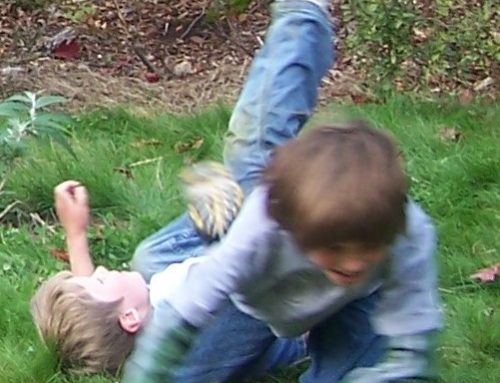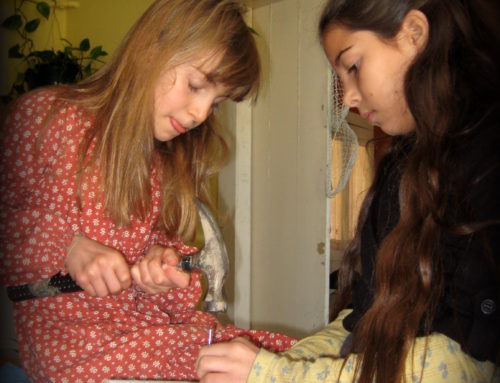How we (adults, parents, adult culture and society) control kids bodies/movement and a New Vision of Respect and Empowerment
I decided to include this list as part of my series on body space/freedom of movement, as I think it is useful to explore these particular areas and examples and to explore a new vision for how things could be.
Control of physical movements-curfews for one, where kids can or can’t go. Forcing kids to sit still in school, not allowing them to move about in ways that would feel good to them. Keeping them confined to a space room, school, building, house etc. Kids who run away from home are forced to return without any say in the matter.
New Vision: Kids have freedom of movement in their bodies to negotiate space and movement in a way that feels right for them as long as it does not cause harm to others. Kids have the right to be at any place at any time that it would be legal for an adult to be and social and physical structures support kids’ moving about in the world both safely and freely. Kids who leave home are not forced to return and viable cultural and societal options exist for kids to live away from their families should they so choose.
Control of eating– Kids are made to eat when they are not hungry, are not allowed to eat when they are hungry and their food choices are often decided for them.
New Vision From the time kids are born they are supported in listening to their body signals, and are fed when they are hungry (NOT on a feeding schedule) and trusted when they communicate that they are full. They have healthy choice about what they eat, have healthy REAL food options and are supported in eating nutritious foods that work for them and their systems, learning the signals and signs their bodies give.
Control of sleeping– forced to go to sleep when not tired, to get up early, to stay awake when they need sleep. Not able to trust own internal judgment and self-regulate their sleeping.
New Vision: Parents support kids in getting the rest they need and helping kids connect to and listen to the signals of their own body. Parents help kids see how their choices in the moment around sleep might impact future activities. Ie staying up late and then not having the energy needed for an activity the next day. As much as possible, parents help kids make their own choices and allow them to experience the consequences of those choices.
Control of dress/ appearance Forcing kids to wear what you think they should wear without clear and just cause, (and I can’t think of too many) is a violation of their person hood. Not giving kids choices over what they wear, how they present themselves. Choosing their hairstyle without their input.
New Vision: Kids are empowered to choose what they would like to wear and to dress themselves. This respects their autonomy and self expression. Similarly kids get to make choices over their own bodies, including how they choose to cut/wear their hair. If parents/adults have concerns about what a kid chooses, then they can communicate their concerns and help kids understand ramifications or possible consequences of their choices.
A Little Story:
My friend and her two-year-old daughter were caught in power struggles around whether or not she would wear a coat in winter. The more my friend insisted, the more her daughter resisted. My sense was that it had more to do with power and autonomy for the little girl than it actually had to do with wearing a coat. I suggested that maybe my friend could let go of fighting with her about it and that if she was actually cold when she was outside, she’d get her coat. A couple of days later we were waiting for the train, and as usual the girl did not want to wear her coat, so without a fuss, we went out without it. Pretty soon she was hugging herself and appearing cold, so I asked her if she were feeling cold and would like her coat. Yes she would. And on it went, end of story, end of power struggle.
Control of speech– “Say your sorry, say please, say thank you, don’t swear etc.” (even when such pleasantries are unauthentic… we teach kids to say things they don’t mean, to be insincere)
New Vision: We encourage kids’ honest and authentic expression, and model the kind of communication and behavior we’d like them to express, never demanding that they say or do something that would go against what is authentic or true for them.
Control over feelings– “Don’t cry,” “Grow up,” “stop acting like a baby,” “say your sorry (when kid really isn’t) etc.”
New Vision: Kids expressions of emotion and feeling are met with empathy and understanding, adults and parents model healthy emotional expression and help kids find constructive outlets for their feelings.
Control of thoughts– through psychological means, through indoctrination. Through invalidation of children’s thoughts and ideas
New Vision: Adults listen to kids and take their perspective seriously. Adults recognize that children are people with rights to their own perspectives and opinions that may differ from their parents or other adults. They have space to explore and pursue thoughts and ideas that are interesting to them and to purse their own way of thinking that is not controlled by the previous generation.
Mind control– Controlling information about life and the world. Keeping kids ignorant about how the world works. Where babies come from for example, finances also, etc. etc. control of information, deciding what one is to learn. Limiting access to information. Giving inaccurate information or partial information that is fear-inducing.
New Vision: Kids have access to accurate and complete information, and are clear partners in deciding what they are to learn and how they are to learn it. Kids are able to access all information that adults can access and are supported in making informed decisions about their lives.
Control of time– Kids time is scheduled for them, mostly through going to school, kids have limited choices about how they spend their time.
New Vision: Kids have choice and say about how they spend their time and what is important to them. The have access to supportive and caring adults that can help them explore options and considerations they might not think of from their perspective and life experience. It is a relationship of power-with and kids are never forced, coerced or bribed into doing things they would not otherwise choose, unless it is to protect them from harming themselves or others. This is never with the intent to punish or make wrong but only with the intent to protect.
Control of social relationships, who kids have as friends, talk to etc.
New Vision: Kids are free to choose their friends and who they talk to and are helped to navigate choices that will maintain their wellbeing. They learn to judge when a situation might not be safe or healthy for them. Kids can choose their boyfriends or girlfriends and how they want to engage with them. Parents and adults can offer guidance and help kids make choices that are respectful and caring to themselves and others
Control over bodies – teens with sexual relationships, also young children being picked up and touched by strangers without their consent. Eating sleeping, bathing etc also apply(see above)
New Vision: Kids bodies are considered their territory and treated with utmost respect. Kids are supported in having authority over their bodies and learning to listen to the signs and signals their bodies are telling them. Adults respect kids bodily privacy and authority in the many ways mentioned above and learn to build relationships of engagement and cooperation rather than invasion and force.
Are there other ways you can think of that kids are controlled and how would you envision it could be different? What thoughts or feelings come up as you read these? Can you connect from your experience of being a kid? What resonates to that kid? As an Adult/Parent how is your perspective different? Can you still connect with the perspective of being a kid and the differences it could make in kids lives, if we shifted our Paradigm and created this New Vision?
Please leave a comment below if you would like!
Check back soon for post about Freedom of Movement


Leave A Comment